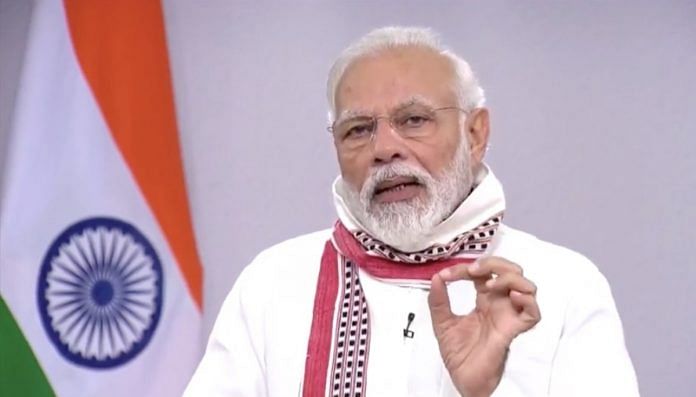Prime Minister Narendra Modi, in the latest edition of his monthly radio programme Mann ki Baat, indicated that some sort of employment generation is being contemplated in the rural locations where labourers have returned during the lockdown. His idea of a Migration Commission, however, must go far beyond just creating rural jobs and seize the moment to set up a workable framework for catalysing internal migration in India.
As we seek to re-open economic activity in our cities in Unlock 1.0, we must be careful to not let the migration policy debate succumb to tired and simplistic binary framings that have been mired in gridlock for decades. Conversations around migration have been for long an argument between votaries of rural development, who seek to prevent ‘distress’ migration by creating opportunities in villages, and those who seek inclusive urbanisation and industrialisation that can offer economic mobility to those moving off the farm. Both sides need to urgently bury their hatchets and collaborate towards finding workable solutions that can do justice to the infinitely complex and diverse realities that exist across India.
Yogi’s dangerous idea
Uttar Pradesh Chief Minister Yogi Adityanath – from whom PM Modi appears to have borrowed the idea of a Migration Commission to create jobs – asking destination states to seek permission from UP government before they can hire workers from his state is a violation of the agency and right to unfettered mobility guaranteed to Indian citizens by the Constitution under Article 19 (1), clauses (d) and (e). Such demands also exacerbate dangerous nativist sentiments (like job protections for locals) and take an unnecessarily confrontational approach to what must be resolved via negotiations.
India is not a well-coordinated single labour market, but an amalgamation of many fragmented and diverse ones. Moreover, large-scale labour migration in India is a function of its peculiar demographics and economic geography, with poorer and highly-populated states in north and eastern India ‘sending’ workers to more industrialised western and southern regions of the country. The remittances sent back home drive consumption and asset creation in the poorest parts of India. Despite the political savviness exhibited by the chief ministers of source states in claiming migrant workers, prospects of creating employment overnight remain daunting in locations that are inherently unattractive to investors, both in terms of infrastructure and regulatory environment.
While destination states worry about the availability of labour to ramp up economic activity, they remain unwilling to roll-out the red carpet for workers. The governments of these states don’t appear to be working to improve living or working conditions for the workers, or announcing any social welfare or wage protection schemes anytime soon. They seem to have left matters to the market. Telangana’s recent request to Bihar for labourers for its rice mills underscores that mobility of workers is going to be a continuing feature of the Indian economy.
But neither political posturing nor policy paralysis will solve the problem of labour redistribution at a time when regular long-distance transportation services are not yet on the horizon and the intermediary chains involving labour contractors are also under severe strain.
Also read: Glitches, poor coverage: India’s digital payment failing labourers when they need it most
Need for a framework
This is an opportune time for the Modi government to take lead and nudge states to develop a broad framework for bilateral and multilateral engagement, which would eventually facilitate safe movement for migrant workers, improve their destination experience and ensure social protection.
First, the proposal to establish the Migration Commission must interface with and build upon the National Migrant Information System, set up by National Disaster Management Authority, to create a robust and dynamic database for labour mobility in India.
Second, the commission must take up the registration of migrants as an urgent task. The lack of a unique worker identification number has prevented frequently mobile inter-state migrants from accessing existing social welfare mechanisms such as the Building and Other Construction Workers board (BOCW). Shramik cards used by states for identification of such workers has provided limited success. A coordinated single national ID for access to multiple benefits could introduce fiscal efficiencies as well.
Third, a Migration Commission should have powers to coordinate among multiple ministries of the government of India. Deliberations of the Working Group on Migration, which submitted its report in 2017, revealed the importance of inter-ministerial coordination in resolving critical issues. For instance, many city-regions and economic corridors where employment is concentrated and dependent on labourers transgress rural-urban jurisdictions and require both the Ministry of Rural Development and the Ministry of Housing and Urban Affairs to intervene. Similarly, multiple ministries, including labour, and women and child development run housing schemes for these labourers.
The Ministry of Housing and Urban Affairs has announced that it is drafting guidelines for affordable rental housing schemes announced by finance minister Nirmala Sitharaman as part of the Covid-19 relief package. The Migration Commission can also intervene to streamline such fragmented approaches to migrant welfare.
The Migration Commission must also act as a hub for inter-state negotiations in creating protocols for the safe mobility of labour back to worksites, designing portability features in social welfare and reconciling fiscal issues that arise from portability.
Migrant labourers are a formidable force in India’s economic life. The government must look beyond the lure of political gestures that pacify hurt migrants and those voters outraged on their behalf. Instead, a Migration Commission is an opportunity to craft a well-planned long-term system to manage labour mobility in India.
Mukta Naik is a Fellow at the Centre for Policy Research, New Delhi. Views are personal.




TRY BIG LOT AND ROSES
A growing economy creates jobs. For the migrants who have returned to their villages, Nrega provides a slender safety net. There is a need to increase its financial allocation, despite fiscal compression. For the rest, an economy that was half dead before the virus, was in fact shedding jobs, is bad news for the poor.